John Keats and On First Looking into Chapman's Homer
英美文学欣赏:JohnKeats
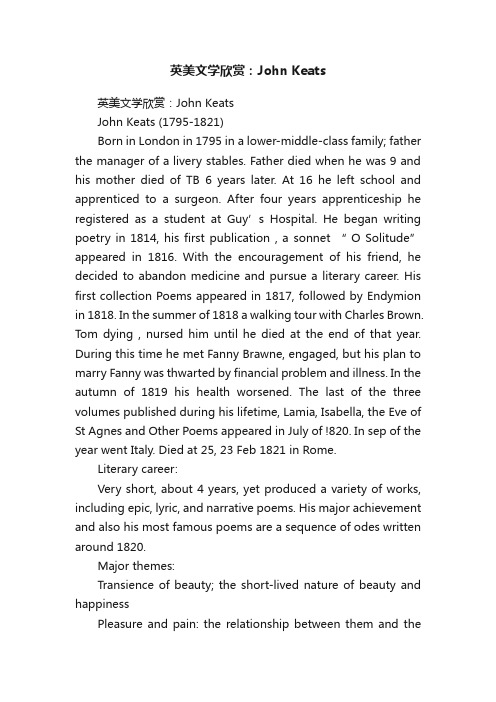
英美文学欣赏:John Keats英美文学欣赏:John KeatsJohn Keats (1795-1821)Born in London in 1795 in a lower-middle-class family; father the manager of a livery stables. Father died when he was 9 and his mother died of TB 6 years later. At 16 he left school and apprenticed to a surgeon. After four years apprenticeship he registered as a student at Guy’s Hospital. He began writing poetry in 1814, his first publication , a sonnet “ O Solitude” appeared in 1816. With the encouragement of his friend, he decided to abandon medicine and pursue a literary career. His first collection Poems appeared in 1817, followed by Endymion in 1818. In the summer of 1818 a walking tour with Charles Brown. Tom dying , nursed him until he died at the end of that year. During this time he met Fanny Brawne, engaged, but his plan to marry Fanny was thwarted by financial problem and illness. In the autumn of 1819 his health worsened. The last of the three volumes published during his lifetime, Lamia, Isabella, the Eve of St Agnes and Other Poems appeared in July of !820. In sep of the year went Italy. Died at 25, 23 Feb 1821 in Rome.Literary career:Very short, about 4 years, yet produced a variety of works, including epic, lyric, and narrative poems. His major achievement and also his most famous poems are a sequence of odes written around 1820.Major themes:Transience of beauty; the short-lived nature of beauty and happinessPleasure and pain: the relationship between them and thevalue of sufferingThe value of enduring art and the role of poetMyth and the supernaturalLove, his attitude to womenKeats learned the art of poetry mainly from the poets of the English Renaissance, such as Spenser and Shakespeare, from Milton and Dante. The artistic aim in his poetry is always to create a beautiful world of imagination as opposed to the sordid reality of his day. He sought to express beauty in all his poems. His leading principle is: “ Beauty is truth, truth beauty”. He expresses the delight which comes not only through the eye and earbut through the senses of touch, taste and smell. His poetry is distinguished by sensuousness and the perfection of form. Known as a sensuous poet.On First Looking into Chapman’s Homer.The first important poem of Keats, written in 1816 at 21. Written in the early morning following an evening spent with Clark; together they had read passages from the Iliad by Homer, translated by Chapman.1. realms of gold: In the old days, America was known as the land of gold where many adventurers went to make their fortune. Here “ the realms of gold” is a metaphor , referring to the realms of great books, chiefly of poetry.2. Western islands—imaginary islands in the western ocean, supposed by ancient Greeks to be very happy and pleasant places. Here refer to realms of great poetry.3. Deep-browed—with heavy and thick eyebrows, suggesting thoughtful or meditative.4. Pure serene—the clear, fresh, vigorous style of Homer.5. watcher of sky: Keats touches our own experience when hedescribes the awe and excitement of a sky watcher at the sight ofa new star;6. Cortez—a Spanish conqueror of Mexico(1485-1554). He cofused Cortez with Vasco Balboa , the Spanish navigator who discovered the Pacific at Darien in 1513.Bolboa and his followers climbed to the top of a hill in Darien and were amazed by the scene before their eyes: a vast ocean lay before them.。
John Keats英文简介
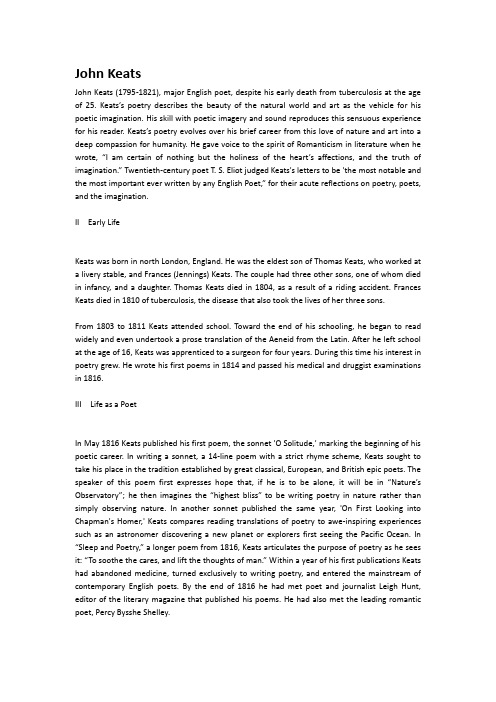
John KeatsJohn Keats (1795-1821), major English poet, despite his early death from tuberculosis at the age of 25. Keats’s poetry describes the beauty of the natural world and art as the vehicle for his poetic imagination. His skill with poetic imagery and sound reproduces this sensuous experience for his reader. Keats’s poetry evolves over his brief career from this love of nature and art into a deep compassion for humanity. He gave voice to the spirit of Romanticism in literature when he wrote, “I am certain of nothing but the holiness of the heart’s affections, and the truth of imagination.” Twentieth-century poet T. S. Eliot judged Keats's letters to be 'the most notable and the most important ever written by any English Poet,” for their acute reflection s on poetry, poets, and the imagination.II Early LifeKeats was born in north London, England. He was the eldest son of Thomas Keats, who worked at a livery stable, and Frances (Jennings) Keats. The couple had three other sons, one of whom died in infancy, and a daughter. Thomas Keats died in 1804, as a result of a riding accident. Frances Keats died in 1810 of tuberculosis, the disease that also took the lives of her three sons.From 1803 to 1811 Keats attended school. Toward the end of his schooling, he began to read widely and even undertook a prose translation of the Aeneid from the Latin. After he left school at the age of 16, Keats was apprenticed to a surgeon for four years. During this time his interest in poetry grew. He wrote his first poems in 1814 and passed his medical and druggist examinations in 1816.III Life as a PoetIn May 1816 Keats published his first poem, the sonnet 'O Solitude,' marking the beginning of his poetic career. In writing a sonnet, a 14-line poem with a strict rhyme scheme, Keats sought to take his place in the tradition established by great classical, European, and British epic poets. The speaker of this poem first expresses hope that, if he is to be alone, it will be in “Nature’s Observatory”; he then imagines the “highest bliss” to be writing poetry in nature rather than simply observing nature. In another sonnet published the same year, 'On First Looking into Chapman's Homer,' Keats compares reading translations of poetry to awe-inspiring experiences such as an astronomer discovering a new planet or explorers first seeing the Pacific Ocean. In “Sleep and Poetry,” a longer poem from 1816, Keats articulates the purpose of poetry as he sees it: “To soothe the cares, and lift the thoughts of man.” Within a year o f his first publications Keats had abandoned medicine, turned exclusively to writing poetry, and entered the mainstream of contemporary English poets. By the end of 1816 he had met poet and journalist Leigh Hunt, editor of the literary magazine that published his poems. He had also met the leading romantic poet, Percy Bysshe Shelley.“Endymion,” written between April and November 1817 and published the following year, is thought to be Keats's richest although most unpolished poem. In the poem, the mortal hero Endymion's quest for the goddess Cynthia serves as a metaphor for imaginative longing—the poet’s quest for a muse, or divine inspiration.Following “Endymion,” Keats struggled with his assumptions about the power of poetry and philosophy to affect the suffering he saw in life. In June of 1818, Keats went on a physically demanding walking tour of England’s Lake District and Scotland, perhaps in search of inspiration for an epic poem. His journey was cut short by the illness of his brother Tom. Keats returned home and nursed his brother through the final stages of tuberculosis. He threw himself into writing the epic “Hyperion,” he wrote to a friend, to ease himself of Tom’s “countenance, his voice and feebleness.'An epic is a long narrative poem about a worthy hero, written in elevated language; this was the principal form used by great poets before Keats. The subject of “Hyperion” is the fall of the primeval Greek gods, who are dethroned by the Olympians, a newer order of gods led by Apollo. Keats used this myth to represent history as the story of how grief and misery teach humanity compassion. The poem ends with the transformation of Apollo into the god of poetry, but Keats left the poem unfinished. His abandonment of the poem suggests that Keats was ready to return to a more personal theme: the growth of a poet's mind. Keats later described the poem as showing 'false beauty proceeding from art' rather than 'the true voice of feeling.' Tom’s death in December 1818 may have freed Keats from the need t o finish “Hyperion.”Two other notable developments took place in Keats’s life in the latter part of 1818. First, “Endymion,” published in April, received negative reviews by the leading literary magazines. Second, Keats fell in love with spirited, 18-year-old Fanny Brawne. Keats's passion for Fanny Brawne is perhaps evoked in 'The Eve of St. Agnes,' written in 1819 and published in 1820. In this narrative poem, a young man follows an elaborate plan to woo his love and wins her heart.Keats’s great crea tive outpouring came in April and May of 1819, when he composed a group of five odes. The loose formal requirements of the ode—a regular metrical pattern and a shift in perspective from stanza to stanza—allowed Keats to follow his mind’s associations. Lite rary critics rank these works among the greatest short poems in the English language. Each ode begins with the speaker focusing on something—a nightingale, an urn, the goddess Psyche, the mood of melancholy, the season of autumn—and arrives at his greater insight into what he values.In “Ode to a Nightingale,” the nightingale’s song symbolizes the beauty of nature and art. Keats was fascinated by the difference between life and art: Human beings die, but the art they make lives on. The speaker in the poem tries repeatedly to use his imagination to go with the bird’s song, but each time he fails to completely forget himself. In the sixth stanza he suddenly remembers what death means, and the thought of it frightens him back to earth and his own humanity.In 'Ode on a Grecian Urn,' the bride and bridegroom painted on the Grecian urn do not die. Theirlove can never fade, but neither can they kiss and embrace. At the end of the poem, the speaker sees the world of art as cold rather than inviting.The last two odes, 'Ode on Melancholy' and 'To Autumn,” show a turn in Keats’s ideas about life and art. He celebrates “breathing human passion” as more beautiful than either art or nature.Keats never lived to write the poetry of 'the agonies, the strife of human hearts' to which he aspired. Some scholars suggest that his revision of “Hyperion,” close to the end of his life, measures what he learned about poetry. In the revision, 'The Fall of Hyperion: A Dream,' Keats boldly makes the earlier poem into the story of his own quest as poet. In a dream, the poem’s speaker must pass through death to enter a temple that receives only those who cannot forget the miseries of the world. Presiding over the shrine is Moneta, a prophetess whose face embodies many of the oppos ites that had long haunted Keats’s imagination—death and immortality, stasis and change, humankind’s goodness and darkness. The knowledge Moneta gives him defines Keats’s new mission and burden as a poet.After September 1819, Keats produced little poetry. His money troubles, always pressing, became severe. Keats and Fanny Brawne became engaged, but with little prospect of marriage. In February 1820, Keats had a severe hemorrhage and coughed up blood, beginning a year that he called his “posthumous existence.” He did manage to prepare a third volume of poems for the press, Lamia, Isabella, The Eve of St. Agnes, and Other Poems.In September 1820, Keats sailed to Italy, accompanied by a close friend. The last months of his life there were haunted by the prospect of death and the memory of Fanny Brawne.。
14行诗英语

14行诗英语The 14-Line PoemPoetry has long been a cherished form of artistic expression, captivating the hearts and minds of readers and writers alike. The 14-line poem, often referred to as a sonnet, holds a special place in the literary landscape, boasting a rich history and a unique structure that has inspired countless poets throughout the ages.At its core, the 14-line poem is a concise and powerful medium that allows the poet to explore a single theme or idea in depth. The traditional structure, which originated in Italy during the 13th century, typically follows a specific rhyme scheme and meter, creating a harmonious and rhythmic flow that carries the reader through the poem's narrative.One of the most striking features of the 14-line poem is its ability to convey complex emotions and ideas within a compact form. The poet must carefully select each word and phrase, crafting a tapestry of language that is both visually and intellectually engaging. The structure, with its three quatrains and a final couplet, provides a framework for the poet to develop a central theme or argument,building towards a climactic resolution or insight.The enduring popularity of the 14-line poem can be attributed to its versatility and adaptability. While the traditional Petrarchan and Shakespearean sonnets have become iconic, poets have also experimented with variations on the form, such as the Spenserian and the Curtal sonnet, each with its own unique twist on the classic structure.In the hands of a skilled poet, the 14-line poem can be a powerful tool for exploring the human experience in all its complexity. From the depths of love and loss to the contemplation of philosophical questions, the sonnet has the ability to capture the essence of the human condition in a concise and captivating manner.One such example is William Shakespeare's famous "Shall I compare thee to a summer's day?", a timeless ode to the enduring power of love. In just 14 lines, Shakespeare weaves a tapestry of imagery and emotion, comparing the beauty of his beloved to the fleeting nature of summer, and ultimately proclaiming the immortality of love through the enduring medium of poetry.Similarly, John Keats' "On First Looking into Chapman's Homer" is a masterful exploration of the transformative power of literature. Through vivid descriptions and a sense of awe, Keats transports thereader to the moment of discovery, when the beauty and wonder of Homer's epic poetry is revealed to him for the first time.The 14-line poem has also been a favored form for poets exploring more abstract or philosophical themes. In "Ozymandias," Percy Bysshe Shelley presents a powerful meditation on the transience of human power and the inevitable decay of empires. By juxtaposing the towering grandeur of a once-great ruler with the desolate reality of his fallen kingdom, Shelley crafts a poignant commentary on the fleeting nature of human ambition and the enduring power of art.Beyond the traditional themes of love, nature, and philosophy, the 14-line poem has also been used to address social and political issues. In "Nuns Fret Not at Their Convent's Narrow Room," William Wordsworth offers a reflection on the power of constraint and limitation, suggesting that it is within the confines of form that true creativity and insight can flourish.In the contemporary era, the 14-line poem continues to captivate and inspire new generations of poets. From the haunting lyricism of Sylvia Plath's "Daddy" to the intricate wordplay of Seamus Heaney's "Digging," the sonnet form remains a vital and enduring part of the literary landscape.As we delve into the rich tapestry of the 14-line poem, we arereminded of the timeless power of language to express the full range of human experience. Whether exploring the depths of emotion or the complexities of the human condition, the sonnet remains a testament to the enduring artistry of poetry and the enduring fascination of the written word.。
希腊神话的对英美文化的影响(完)
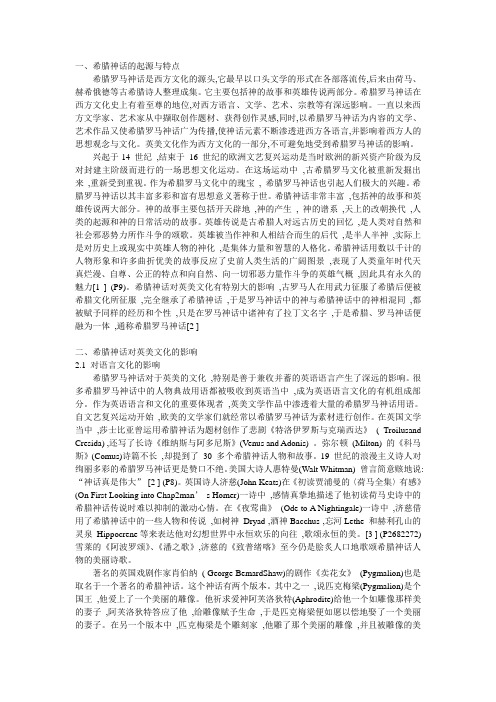
一、希腊神话的起源与特点希腊罗马神话是西方文化的源头,它最早以口头文学的形式在各部落流传,后来由荷马、赫希俄德等古希腊诗人整理成集。
它主要包括神的故事和英雄传说两部分。
希腊罗马神话在西方文化史上有着至尊的地位,对西方语言、文学、艺术、宗教等有深远影响。
一直以来西方文学家、艺术家从中撷取创作题材、获得创作灵感,同时,以希腊罗马神话为内容的文学、艺术作品又使希腊罗马神话广为传播,使神话元素不断渗透进西方各语言,并影响着西方人的思想观念与文化。
英美文化作为西方文化的一部分,不可避免地受到希腊罗马神话的影响。
兴起于14 世纪,结束于16 世纪的欧洲文艺复兴运动是当时欧洲的新兴资产阶级为反对封建主阶级而进行的一场思想文化运动。
在这场运动中,古希腊罗马文化被重新发掘出来,重新受到重视。
作为希腊罗马文化中的瑰宝, 希腊罗马神话也引起人们极大的兴趣。
希腊罗马神话以其丰富多彩和富有思想意义著称于世。
希腊神话非常丰富,包括神的故事和英雄传说两大部分。
神的故事主要包括开天辟地,神的产生, 神的谱系,天上的改朝换代,人类的起源和神的日常活动的故事。
英雄传说是古希腊人对远古历史的回忆,是人类对自然和社会邪恶势力所作斗争的颂歌。
英雄被当作神和人相结合而生的后代,是半人半神,实际上是对历史上或现实中英雄人物的神化,是集体力量和智慧的人格化。
希腊神话用数以千计的人物形象和许多曲折优美的故事反应了史前人类生活的广阔图景,表现了人类童年时代天真烂漫、自尊、公正的特点和向自然、向一切邪恶力量作斗争的英雄气概,因此具有永久的魅力[1 ] (P9)。
希腊神话对英美文化有特别大的影响,古罗马人在用武力征服了希腊后便被希腊文化所征服,完全继承了希腊神话,于是罗马神话中的神与希腊神话中的神相混同,都被赋予同样的经历和个性,只是在罗马神话中诸神有了拉丁文名字,于是希腊、罗马神话便融为一体,通称希腊罗马神话[2 ]二、希腊神话对英美文化的影响2.1 对语言文化的影响希腊罗马神话对于英美的文化,特别是善于兼收并蓄的英语语言产生了深远的影响。
John_Keats
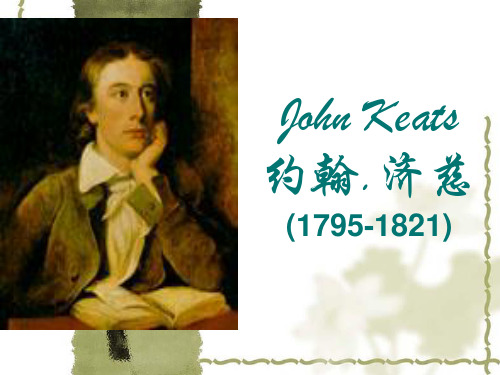
JohnKeats could and Fanny Brawn Keats not afford to support a wife, Because
they kept the engagement a secret from all but their closest friends. Keats wrote her a flood of notes and letters till March 1820. In a letter he wrote, I have vex'd you too much. But for Love! Can I help it? You are always new. The last of your kisses was ever the gracefullest. When you pass'd my window home yesterday, I was filled with as much admiration as if I had then seen you for the first time. You uttered a half complaint once that I only lov'd your Beauty. Have I nothing else then to
3. Short Poems
(1) On a Grecian Urn,“希腊 古 瓮颂”.
Keats was born in London on October 31, 1795 as the son of a livery-stable manager. He was the oldest of four children, who remained deeply devoted to each other. After their father died in 1804, Keats's mother remarried but the marriage was soon broken. She moved with the children, John and his sister Fanny and brothers George and Tom, to live with her mother at Edmonton, near London. She died of tuberculosis in 1810.
JohnKeats约翰
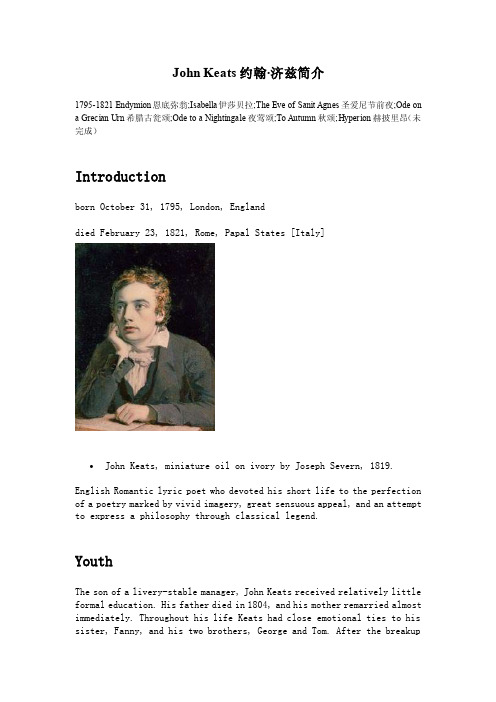
John Keats约翰·济兹简介1795-1821 Endymion恩底弥翁;Isabella伊莎贝拉;The Eve of Sanit Agnes圣爱尼节前夜;Ode on a Grecian Urn希腊古瓮颂;Ode to a Nightingale夜莺颂;To Autumn秋颂;Hyperion赫披里昂(未完成)Introductionborn October 31, 1795, London, Englanddied February 23, 1821, Rome, Papal States [Italy]John Keats, miniature oil on ivory by Joseph Severn, 1819.English Romantic lyric poet who devoted his short life to the perfection of a poetry marked by vivid imagery, great sensuous appeal, and an attempt to express a philosophy through classical legend.YouthThe son of a livery-stable manager, John Keats received relatively little formal education. His father died in 1804, and his mother remarried almost immediately. Throughout his life Keats had close emotional ties to his sister, Fanny, and his two brothers, George and Tom. After the breakupof their mother's second marriage, the Keats children lived with their widowed grandmother at Edmonton, Middlesex. John attended a school at Enfield, two miles away, that was run by John Clarke, whose son Charles Cowden Clarke did much to encourage Keats's literary aspirations. At school Keats was noted as a pugnacious lad and was decidedly “not literary,” but in 1809 he began to read voraciously. After the death of the Keats children's mother in 1810, their grandmother put the children's affairs into the hands of a guardian, Richard Abbey. At Abbey's instigation John Keats was apprenticed to a surgeon at Edmonton in 1811. He broke off his apprenticeship in 1814 and went to live in London, where he worked as a dresser, or junior house surgeon, at Guy's and St. Thomas' hospitals. His literary interests had crystallized by this time, and after 1817 he devoted himself entirely to poetry. From then until his early death, the story of his life is largely the story of the poetry he wrote.Early worksCharles Cowden Clarke had introduced the young Keats to the poetry of Edmund Spenser and the Elizabethans, and these were his earliest models. His first mature poem is the sonnet "On First Looking Into Chapman's Homer" (1816), which was inspired by his excited reading of George Chapman's classic 17th-century translation of the Iliad and the Odyssey. Clarke also introduced Keats to the journalist and contemporary poet Leigh Hunt, and Keats made friends in Hunt's circle with the young poet John Hamilton Reynolds and with the painter Benjamin Haydon. Keats's first book, Poems, was published in March 1817 and was written largely under “Huntian” influence. This is evident in the relaxed and rambling sentiments evinced and in Keats's use of a loose form of the heroic couplet and light rhymes. The most interesting poem in this volume is "Sleep and Poetry," the middle section of which contains a prophetic view of Keats's own poetical progress. He sees himself as, at present, plunged in the delighted contemplation of sensuous natural beauty but realizes that he must leave this for an understanding of “the agony and strife of human hearts.” Otherwise the volume is remarkable only for some delicate natural observation and some obvious Spenserian influences.In 1817 Keats left London briefly for a trip to the Isle of Wight and Canterbury and began work on Endymion, his first long poem. On his return to London he moved into lodgings in Hampstead with his brothers. Endymion appeared in 1818. This work is divided into four 1,000-line sections, and its verse is composed in loose rhymed couplets. The poem narrates a version of the Greek legend of the moon goddess Diana's (or Cynthia's) love forEndymion, a mortal shepherd, but Keats puts the emphasis on Endymion's love for Diana rather than on hers for him. Keats transformed the tale to express the widespread Romantic theme of the attempt to find in actuality an ideal love that has been glimpsed heretofore only in imaginative longings. This theme is realized through fantastic and discursive adventures and through sensuous and luxuriant description. In his wanderings in quest of Diana, Endymion is guilty of an apparent infidelity to his visionary moon goddess and falls in love with an earthly maiden to whom he is attracted by human sympathy. But in the end Diana and the earthly maiden turn out to be one and the same. The poem equates Endymion's original romantic ardour with a more universal quest for a self-destroying transcendence in which he might achieve a blissful personal unity with all creation. Keats, however, was dissatisfied with the poem as soon as it was finished.Personal crisisIn the summer of 1818 Keats went on a walking tour in the Lake District (of northern England) and Scotland with his friend Charles Brown, and his exposure and overexertions on that trip brought on the first symptoms of the tuberculosis of which he was to die. On his return to London a brutal criticism of his early poems appeared in Blackwood's Magazine, followed by a similar attack on Endymion in the Quarterly Review. Contrary to later assertions, Keats met these reviews with a calm assertion of his own talents, and he went on steadily writing poetry. But there were family troubles. Keats's brother Tom had been suffering from tuberculosis for some time, and in the autumn of 1818 the poet nursed him through his last illness. About the same time, he met Fanny Brawne, a near neighbour in Hampstead, with whom he soon fell hopelessly and tragically in love. The relation with Fanny had a decisive effect on Keats's development. She seems to have been an unexceptional young woman, of firm and generous character, and kindly disposed toward Keats. But he expected more, perhaps more than anyone could give, as is evident from his overwrought letters. Both his uncertain material situation and his failing health in any case made it impossible for their relationship to run a normal course. After Tom's death (George had already gone to America), Keats moved into Wentworth Place with Brown; and in April 1819 Brawne and her mother became his next-door neighbours. About October 1819 Keats became engaged to Fanny.The year 1819Keats had written "Isabella," an adaptation of the story of the "Pot of Basil" in Giovanni Boccaccio's Decameron, in 1817–18, soon after the completion of Endymion, and again he was dissatisfied with his work. It was during the year 1819 that all his greatest poetry was written—"Lamia," "The Eve of St. Agnes," the great odes ( "On Indolence," "On a Grecian Urn," "To Psyche," "To a Nightingale," "On Melancholy," and "To Autumn" ), and the two versions of Hyperion. This poetry was composed under the strain of illness and his growing love for Brawne; and it is an astonishing body of work, marked by careful and considered development, technical, emotional, and intellectual. "Isabella," which Keats himself called “a weak-sided poem,” contains some of the emotional weaknesses of Endymion; but "The Eve of St. Agnes" may be considered the perfect culmination of Keats's earlier poetic style. Written in the first flush of his meeting with Brawne, it conveys an atmosphere of passion and excitement in its description of the elopement of a pair of youthful lovers. Written in Spenserian stanzas, the poem presents its theme with unrivaled delicacy but displays no marked intellectual advance over Keats's earlier efforts. "Lamia" is another narrative poem and is a deliberate attempt to reform some of the technical weaknesses of Endymion. Keats makes use in this poem of a far tighter and more disciplined couplet, a firmer tone, and more controlled description.The odes are Keats's most distinctive poetic achievement. They are essentially lyrical meditations on some object or quality that prompts the poet to confront the conflicting impulses of his inner being and to reflect upon his own longings and their relations to the wider world around him. All the odes were composed between March and June 1819 except "To Autumn," which is from September. The internal debates in the odes centre on the dichotomy of eternal, transcendent ideals and the transience and change of the physical world. This subject was forced upon Keats by the painful death of his brother and his own failing health, and the odes highlight his struggle for self-awareness and certainty through the liberating powers of his imagination. In the "Ode to a Nightingale" a visionary happiness in communing with the nightingale and its song is contrasted with the dead weight of human grief and sickness, and the transience of youth and beauty—strongly brought home to Keats in recent months by his brother's death. The song of the nightingale is seen as a symbol of art that outlasts the individual's mortal life. This theme is taken up more distinctly in the "Ode on a Grecian Urn." The figures of the lovers depicted on the Greek urn become for him the symbol of an enduring but unconsummated passion that subtly belies the poem'scelebrated conclusion, “Beauty is truth, truth beauty,—that is all ye know on earth, and all ye nee d to know.” The "Ode on Melancholy" recognizes that sadness is the inevitable concomitant of human passion and happiness; the transience of joy and desire is an inevitable aspect of the natural process. But the rich, slow movement of this and the other odes suggests an enjoyment of such intensity and depth that it makes the moment eternal. The "Ode to Autumn" is essentially the record of such an experience. Autumn is seen not as a time of decay but as a season of complete ripeness and fulfillment, a pause in time when everything has reached fruition, and the question of transience is hardly raised. These poems, with their rich and exquisitely sensuous detail and their meditative depth, are among the greatest achievements of Romantic poetry. With them should be mentioned the ballad "La Belle Dame sans merci," of about the same time, which reveals the obverse and destructive side of the idyllic love seen in "The Eve of St. Agnes."Keats, detail of an oil painting by Joseph Severn, 1821; in the National Portrait Gallery, LondonKeats's fragmentary poetic epic, Hyperion, exists in two versions, the second being a revision of the first with the addition of a long prologue in a new style, which makes it into a different poem. Hyperion was begun in the autumn of 1818, and all that there is of the first version was finished by April 1819. In September Keats wrote to Reynolds that he had given up Hyperion, but he appears to have continued working on the revised edition, The Fall of Hyperion, during the autumn of 1819. The two versions of Hyperion cover the period of Keats's most intense experience, both poetical and personal. The poem is his last attempt, in the face of increasing illness and frustrated love, to come to terms with the conflict between absolute value and mortal decay that appears in other forms in his earlier poetry. The epic's subject is the supersession of the earlier Greek gods, the Titans, by the later Olympian gods. Keats's desire to write something unlike the luxuriant wandering of Endymion is clear, and he thus consciously attempts to emulate the epic loftiness of John Milton's Paradise Lost. The poem opens with the Titans already fallen, like Milton's fallen angels, and Hyperion, the sun god, is their one hope of further resistance, like Milton's Satan. There are numerous Miltonisms of style, but these are subdued in the revised version, as Keats felt unhappy with them; and the basis of the writing is revealed after all as a more austere and disciplined version of Keats's own manner. There is not enough of the narrative to make its ultimate direction clear; but it seems that the poem's hero was to be the young Apollo, the god of poetry. So, as Endymion was an allegory of the fate of the lover of beauty in theworld, Hyperion was perhaps to be an allegory of the poet as creator. Certainly this theme is taken up explicitly in the new prologue to the second version.The second version of Hyperion is one of the most remarkable pieces of writing in Keats's work; the blank verse has a new energy and rapidity, and the vision is presented with a spare grandeur, rising to its height in the epiphany of the goddess Moneta, who reveals to the dreamer the function of the poet in the world. It is his duty to separate himself from the mere dreamer and to share in the sufferings of humankind. The theme is not new to Keats—it appears in his earliest poetry—but it is here realized far more intensely. Yet with the threat of approaching death upon him, Keats could not advance any further in the direction that he foresaw as the right one, and the poem remains a fragment.Last yearsThere is no more to record of Keats's poetic career. The poems "Isabella," "Lamia," "The Eve of St. Agnes," and Hyperion and the odes were all published in the famous 1820 volume, the one that gives the true measure of his powers. It appeared in July, by which time Keats was evidently doomed. He had been increasingly ill throughout 1819, and by the beginning of 1820 the evidence of tuberculosis was clear. He realized that it was his death warrant, and from that time sustained work became impossible. His friends Brown, the Hunts, and Brawne and her mother nursed him assiduously through the year. Percy Bysshe Shelley, hearing of his condition, wrote offering him hospitality in Pisa; but Keats did not accept. When Keats was ordered south for the winter, Joseph Severn undertook to accompany him to Rome. They sailed in September 1820, and from Naples they went to Rome, where in early December Keats had a relapse. Faithfully tended by Severn to the last, he died in Rome.LettersThe prime authority both for Keats's life and for his poetical development is to be found in his letters. This correspondence with his brothers and sister, with his close friends, and with Fanny Brawne gives the most intimate picture of the admirable integrity of Keats's personal characterand enables the reader to follow closely the development of his thought about poetry—his own and that of others.His letters evince a profound thoughtfulness combined with a quick, sensitive, undidactic critical response. Spontaneous, informal, deeply thought, and deeply felt, these are among the best letters written by any English poet. Apart from their interest as a commentary on his work, they have the right to independent literary status.ReputationIt is impossible to say how much has been lost by Keats's early death. His reputation grew steadily throughout the 19th century, though as late as the 1840s the Pre-Raphaelite painter William Holman could refer to him as “this little-known poet.” His influence is found everywhere in the decorative Romantic verse of the Victorian Age, from the early work of Alfred Tennyson onward. His general emotional temper and the minute delicacy of his natural observation were greatly admired by thePre-Raphaelites, who both echoed his poetry in their own and illustrated it in their paintings. Keats's 19th-century followers on the whole valued the more superficial aspects of his work; and it has been largely left for the 20th century to realize the full range of his technical and intellectual achievement.Graham Goulder Hough Ed.Additional ReadingThree major critical biographies are Walter Jackson Bate, John Keats (1963, reprinted 1978); Robert Gittings, John Keats (1968, reissued 1985); and Aileen Ward, John Keats: The Making of a Poet, rev. ed. (1986). Special studies are Claude Lee Finney, The Evolution of Keats's Poetry, 2 vol. (1936, reprinted 1963), a detailed account of the origins of the poems; M.R. Ridley, Keats' Craftsmanship (1933, reissued 1963); John Spencer Hill (ed.), Keats: The Narrative Poems(1983), a collection of 19th- and 20th-century criticism; and Wolf Z. Hirst, John Keats(1981), a study of his life and work. Helen Vendler, The Odes of John Keats(1983); and John Barnard, John Keats (1987), are both critical assessments.。
John Keats

His wn A
as a sensuous poet (给人以美的享受的诗人).
voice through which beauty expresses itself.
He
is, like Shakespeare, Milton and Wordsworth, one of the indisputable great English poets.
Odes His
His
Expression
Major Literary Works
1. Poems,《诗集》,his first book.
(1)“O Solitude”, “孤寂”, a sonnet published in Hunt’s The Examiner《检查官》.
(2)“On First Looking into Chapman’s Homer”, “初读查普曼译荷马史诗”, a sonnet. (3) “Sleep and Poetry”, “睡与诗”
John Keats
石乃馨 刘一鹤 潘倩倩
Major Literary Works
John
Keats Produced a variety of work, including epic, lyric and narrative poems.
( 颂诗 , 赋 ) are regarded as Keats ’ s most important and mature works. first poem: Lines in Imitation of Spenser《仿斯宾塞》 (1814) first important poem: On First Looking into Chapman’s Homer (1816) of his own poetic aspirations: Sleep and Poetry (1817)
英国文学史及选读复习7 William Shakespeare 1564
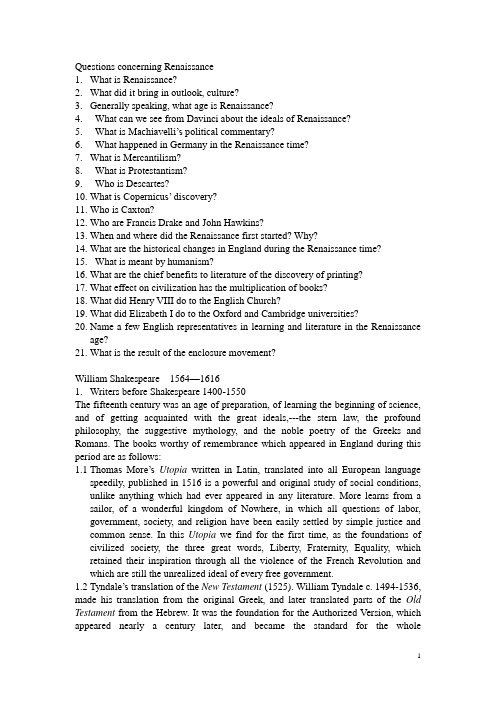
Questions concerning Renaissance1.What is Renaissance?2.What did it bring in outlook, culture?3.Generally speaking, what age is Renaissance?4.What can we see from Davinci about the ideals of Renaissance?5.What is Machiavelli’s political commentary?6.What happened in Germany in the Renaissance time?7.What is Mercantilism?8.What is Protestantism?9.Who is Descartes?10.What is Copernicus’ discovery?11.Who is Caxton?12.Who are Francis Drake and John Hawkins?13.When and where did the Renaissance first started? Why?14.What are the historical changes in England during the Renaissance time?15.What is meant by humanism?16.What are the chief benefits to literature of the discovery of printing?17.What effect on civilization has the multiplication of books?18.What did Henry VIII do to the English Church?19.What did Elizabeth I do to the Oxford and Cambridge universities? a few English representatives in learning and literature in the Renaissanceage?21.What is the result of the enclosure movement?William Shakespeare 1564—16161.Writers before Shakespeare 1400-1550The fifteenth century was an age of preparation, of learning the beginning of science, and of getting acquainted with the great ideals,---the stern law, the profound philosophy, the suggestive mythology, and the noble poetry of the Greeks and Romans. The books worthy of remembrance which appeared in England during this period are as follows:1.1Thomas More’s Utopia written in Latin, translated into all European languagespeedily, published in 1516 is a powerful and original study of social conditions, unlike anything which had ever appeared in any literature. More learns from a sailor, of a wonderful kingdom of Nowhere, in which all questions of labor, government, society, and religion have been easily settled by simple justice and common sense. In this Utopia we find for the first time, as the foundations of civilized society, the three great words, Liberty, Fraternity, Equality, which retained their inspiration through all the violence of the French Revolution and which are still the unrealized ideal of every free government.1.2Tyndale’s translation of the New Testament (1525). William Tyndale c. 1494-1536, made his translation from the original Greek, and later translated parts of the Old Testament from the Hebrew. It was the foundation for the Authorized V ersion, which appeared nearly a century later, and became the standard for the wholeEnglish-speaking race.1.3Wyatt(1503?-1542) and Surrey(1517?-1547)In Tottel’s Miscellany, the first printed collection of miscellaneous English poems, half of the poems were the work of Sir Thomas Wyatt and of Henry Howard, earl of Surrey. Both together wrote amorous sonnets modeled after the Italians, introducing a new verse form which has been a favorite ever since with English poets. Surrey is noted for his translation of two books of Virgil in “strange meter”. The strange meter was the blank verse, which in the hands of Shakespeare and Milton was used to make the world’s masterpieces.2.Shakespeare2.1 his lifeBorn in 1564 in Stratford-on-Avon, son of a small farmer, later a businessman of gloves. At 7 he attended the local grammar school, learned Latin and Greek. He distinguished himself at school because in his younger years he was a school master in the country. There is a legend according to which he had poached upon the lands of a certain Sir Thomas Lucy, a rich landlord and country magistrate. He was caught and severely punished. He avenged himself by composing a satirical ballad. V ery soon it became so popular throughout the countryside that wherever Sir Thomas Lucy appeared he was met with the strains of the ballad. Sir Thomas was enraged and redoubled his persecution to such a degree that Shakespeare was compelled to leave Stratford and seek refuge in London.In 1582 he married a farmer’s daughter Anne Hathaway. A son was born to him, the boy was named Hamnet, obviously after Hamlet, the hero of the tragedy written by Thomas Kyd.In London he became acquainted with certain theatrical company, became an actor and playwright. Later he became a shareholder of the theater. His activities as a dramatic poet, actor and proprietor lasted till the year 1612 when he retired from the stage and returned to Stratford. He died in 1616.2.2Dramatic careerfirst period 1587-1595His first period of dramatic career was one of the apprenticeship. It is marked by youthfulness and exuberance of imagination, by extravagance of language, and by the frequent use of rimed couplets with his blank verseTypical works of this period are his early poems, Love’s L abor’s Lost, Two Gentlemen of Verona, and Richard III.second period 1595-1600It is the period of rapid growth and development. The plays show more careful and artistic work, better plots, and a marked increase in knowledge of human nature.e.g. The Merchant of Venice, Midsummer Night’s Dream ,As you Like it, Henry IV. third period 1600-1607A period of gloom and depression, from 1600 to 1607, which marks the full maturityof his powers.The Sonnets with their note of personal disappointment, Twelfth Night, which is Sha kespeare’s “farewell to mirth,”and his great tragedies, Hamlet, Lear, Macbeth, Othello, Julius Caesar, belong to this period.fourth period1607—1612A period of restored serenity, of calm after storm, which marked the last years of the poet’s literary wo rk.The Winter’s Tale and The Tempest are the best of his later plays.3.Non-dramatic poemsHis non-dramatic poetry consists of two long narrative poems and sequence of 154 sonnets. Narrative poems Venus and Adonis, The Rape of Lucrece.He borrowed the outline of Venus and Adonis from Ovid’s Metamorphosis, but took details from some of the other stories. The poem tells the story of how V enus the Goddess of Love was in love with the handsome boy Adonis and how the latter was killed by a boar while hunting. The poem contains some vivid pictures of amorous V enus and wayward Adonis, a frank eulogy of earthly love, which can be regarded a healthy anti-dote to the asceticism of the Middle Ages.The Rape of Lucrece is a tragic tale about the chaste Roman dame Lucrece who, after being raped by the terrible Tarquin, committed suicide and then was revenged. It condemns lust and tyranny and praises healthful love.4.Sonnets3.1general introduction to Shakespeare’s 154 sonnets.154 sonnets are the only direct expression of his own feelings, for his plays are the most impersonal in all literature.Among the sonnets, numbers 1-126 are addressed to a young man, beloved of the poet, of superior beauty and rank but of somewhat questionable morals and constancy. Sonnets 127-152 form a less coherent group. They involve a mistress of the poet, a mysterious “Dark Lady”. The poet’s attitude to her is frankly lustful, with occasional pangs of conscience and feeling of revulsion. The final two sonnets are translations or adaptations of some version of a Greek epigram, and they evidently refer to the hot springs at Bath.3.2definition of sonnet:a poem of 14 lines, usually in iambic pentameter, restricted to a definite rhymescheme. There are two prominent types: the Petrarchan, composed of an octave and a sestet (rhyming abbaabba cdecde/cdccdc/cdedce); and the Shakespearean, consisting of three quatrains and a couplet (rhyming abab cdcd efef gg). Sonnets were highly popular in Renaissance Italy, and thereafter in Spain, Portugal, France, and England. German and English romantics revived the form, which remains popular. Notable sonneteers include, besides Petrarch and Shakespeare, Dante, Edmund Spenser, Philip Sidney, John Keats, Elizabeth Barrett Browning, George Meredith, Edna St. Vincent Millay and W. H. Auden.e.g. Sonnet 75 by Edmund SpenserOne day I wrote her name upon the strand,But came the waves and washed it away:Agayne I wrote it with a second hand,But came the tyde, and made my paynes his pray.“V ayne man,” sayd she, “that doest in vaine assay,A mortal thing so to immortalize,For I my selve shall lyke to this decay,And eek my name bee wiped out lykewize.”“Not so,” quod I, “let baser things devize,To dy in dust, but you shall live by fame:My verse your virtues rare shall eternize,And in the heavens wryte your glorious name.Where whenas death shall all the world subdew,Our love shall live, and later life renew.”On First Looking into Chapman’s Homer by John KeatsMuch have I traveled in the realms of gold,And many goodly states and kingdoms seen;Round many western islands have I beenWhich bards in fealty to Apollo hold.Oft of one wide expanse had I been toldThat deep-browed Homer ruled as his demesne;Y et did I never breathe its pure sereneTill I heard Chapman speak out loud and bold:Then Felt I like some watcher of the skiesWhen a new planet swims into his ken;Or like stout Cortez when with eagle eyesHe stared at the Pacific---and all his menLooked at each other with a wild surmise---Silent, upon a peak in Darien.4.Shakespeare’s place and influenceHe holds, by general acclamation, the foremost place in the world’s literature, and his overwhelming greatness renders it difficult to criticize or even to praise him. His genius included all the world of nature and of men. To study nature in his works is like exploring a new and beautiful country; to study man in his works is like going into a great city, viewing the motley crowd as one views a great masquerade in which past and present mingle freely and familiarly, as if the dead were all living again. And the marvelous thing, in this masquerade of all sorts and conditions of men, is that Shakespeare lifts the mask from every face, lets us see the man as he is in his own soul, and shows us in each one some germ of good, some “soul of goodness” even inthings evil. For Shakespeare strikes no uncertain note, and raises no doubts to add to the burden of our own. Good always overcomes evil in the long run; and love, faith, work, and duty are the four elements that in all ages make the world right. To criticize or praise the genius that creates these men and women is to criticize or praise humanity itself.He influenced many great writers, e.g. Goethe; his influence upon the English language and thought is beyond calculation. Shakespeare and King James Bible are the two great conservators of the English speech. One who habitually reads them finds himself possessed of a style and vocabulary that are beyond criticism. Even those who read no Shakespeare are still unconsciously guided by him, for his thought and expression have so pervaded English life and literature that it is impossible, so long as one speaks the English language, to escape his influence.WinterWhen icicles hang by the wall,And Dick the shepherd blows his nail,And Tom bears logs into the hall,And milk comes frozen home in pail,When blood is nipped and ways be foul,Then nightly sings the staring owl,“Tu-whit, tu-who!”A merry note,While greasy Joan doth keel the pot.When all aloud the wind doth blow,And coughing drowns the parson’s saw,And birds sit brooding in the snow,And Marian’s nose looks red and raw,When roasted crabs hiss in the bowl,Then nightly sings the staring owl,“Tu-whit, tu-who!”A merry note,While greasy Joan doth keel the pot.SpringWhen daisies pied and violets blueAnd lady-smocks all silver-whiteAnd cuckoo-buds of yellow hueDo paint the meadows with delight,The cuckoo then, on every tree,Mocks married men; for thus sings he,“Cuckoo!Cuckoo, cuckoo!” O, word of fear, Unpleasing to a married ear!When shepherds pipe on oaten straws,And merry larks are ploughmen’s clocks, When turtles tread, and rooks, and daws, And maidens bleach their summer smocks, The cuckoo then, on every tree,Mocks married men; for thus sings he,“Cuckoo! Cuckoo, cuckoo!” O, word of fear, Unpleasing to a married ear!。
On First Looking into Chapman’s Homer ”(1816)
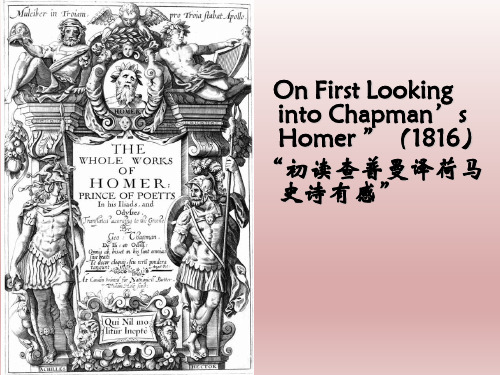
Then felt I like some watcher of the skies
•Simile 于是我的情感犹如一位观象家,
go into his eyesight
When a new planet swims into his ken;
Translation
• 初读贾浦曼译荷马有感
•
约翰·济慈
• 我游历了很多金色的国度,
• 看过不少好的城邦和王国,
• 还有多少西方的海岛,歌 者
• 都已使它们向阿波罗臣服。
• 我常听到有一境域,广阔 无垠,
• 智慧的荷马在那里称王,
• 我从未领略的纯净、安详
• 直到我听见贾浦曼的声音
• 无畏而高昂。于是,我的 情感
?此地长眠者声名水上书otherworks?仿斯宾塞?伊莎贝拉?圣亚尼节前夜许佩里恩?夜莺颂?希腊古瓮颂秋颂?无情的妖女?忧郁颂?白天逝去了生命之手?海伯利安?蝈蝈和蛐蛐每当我害怕明亮的星?给拜伦backgroundonfirstlookingintochapmanshomerisoneofaveryinfluentialpoembykeatsafterreadinggeorgechapmanstranslationofhomerspoemiliadandodysseytheyoungkeatswasdeeplytouchedbythevigorandvitalitycontainedinthepoemthenwritedownthissonnet十四行诗
Thank You
• Written in October 1816,this is the first entirely successful (surviving)poem he wrote.John Middleton Murry called it “one of the finest sonnets in the English language.
john keats(济慈)
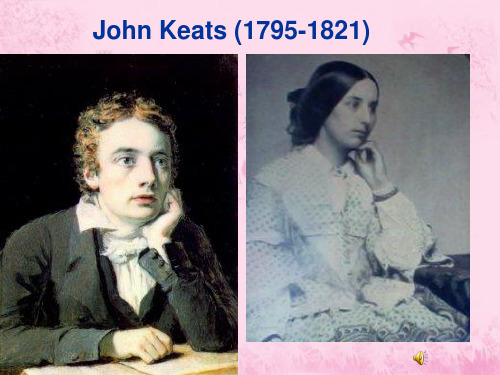
1、每当我害怕 2、哦,孤独 3、明亮的星 4、夜莺颂 5、希腊古瓮颂 6、人生的四季 7、给拜伦 8、咏阿丽莎巉岩 9、初读贾浦曼译荷马有感 10、无情的妖女 11、忧郁颂 12、秋颂 13、蝈蝈和蛐蛐
His Position in English Literature
Life Story
He was born in London on October 31, 1795; His father died when he was nine and his mother died when he was fifteen. In the family atmosphere at Clarke's, Keats developed an interest in classics and history which would stay with him throughout his short life. The headmaster's son, Charles Cowden Clarke, would become an important influence, mentor and friend, introducing Keats to Renaissance literature including Tasso, Spenser and Chapman's translations. Published his first book, Poems, in 1817; Died in Rome on February 23, 1821.
Major Literary Works
Produced a variety of work, including epic, lyric (抒情诗)and narrative poems. Odes(颂诗,赋)are regarded as Keats‟s most important and mature works. Lines in Imitation of Spenser《仿斯宾塞》 (1814): his first poem On First Looking into Chapman’s Homer (1816): his first important poem Sleep and Poetry (1817): expression of his own poetic aspirations
英国文学简要笔记

1.John Donne 多恩--- Metaphysical poetry玄学派诗人Major works: The Canonization/A V alediction: Forbidding Mouring/Song 2.John Milton 弥尔顿---Paradise Lost失乐园The epic is written in blank verse.The conflict is between human love and spiritual duty. The freedom of the will is the keystone of Milton’s creed(纲领).3.John Bunyan班扬--- The Pilgrim’s Progress天路历程Thackeray’s the Vanity Fair an excerpt from the Pilgrim’s ProgressThe Pilgrim’s Progress is an allegory寓言Theme:the Puritan struggle of freedom of worship, the eternal struggle of man to find unity with God.His language is concrete, living and colloquial.4.Daniel Defoe笛福---Moll Flanders /Robinson Crusoe笛福18世纪的小说家5.Jonathan Swift斯威夫特---A Modest Proposal /Gulliver’s Travels /ATale of TubHe is a satirist讽刺家.“Proper words in proper place ,makes the true definition of a style”6.Alexander Pope蒲柏---the first one introduce rationalism to England.He is the great poet of the classical in the first half of the 18th century.He is a master of heroic couplets.Major works:The Rape of the Lock劫发记/An Essay on Man人论7.Fielding菲尔丁---The father of English novelFirst to write a “Comic epic in prose”散文体史诗Adopted” the third-person narration”Masterpiece: The Story of Tom Jones ,A Foundling8.Thomas Gray格雷---Elegy Written in a Country Churchyard墓畔挽歌The leader of the sentimental poetry of the day.9.Robert Burns彭斯---His poem written in the Scottish dialect.<A Red, Red Rose>(1)How does the narrator in the love song express his love?To use many figures of speeches: simile, metaphor, repetition.(2)Why is this poem so touching to the readers?A: directly passionateB: artistic recreation; imagery presentationC: in repetition to stir on echoing effect.10.William Blake布雷克---poet & engraver雕刻家Major works: The Song of Innocence & the Song of Experience<The Chimney Sweeper>扫烟囱的小孩(1)What is the young child speaks of his “father and mother” whom doeshe refer to?The indifference & ruthlessness of the adults.(2)What is the “little black thing” in the poem?Sweeper(3)What is the theme of poem?To satire the indifference & ruthlessness of the adults, and the society. 11.The Age of Romance(1798-1835)Background:A. three revolution (Industrial, American, French).B. the abolition of slavery in British colonies.C. the introduction of system of national education.D. the Factory Acts工厂法案by which the employment children under nine was forbidden by the law.E. the Lyrical Ballads----Wordsworth & ColeridgeCharacterize by 5 “I”: Imagination, Intuition, Idealism, Inspiration, Individuality12.The Lake Poets湖畔诗人---- Wordsworth & Coleridge & Southey骚塞The Satanic school 撒旦派诗人---- Byron & Shelly & Keats13.Wordsworth 华兹华斯----“emotion recollected in tranquility”Lyrical Ballads 抒情民谣:Theme:Sympathy with the poor, simple peasants, a passionate love of nature and the simplicity and purity of the language.14. <I Wandered Lonely as a Cloud>Rhyme scheme: ab ab cc, iambic tetrameter抑扬格四音步(1)What does the image of cloud suggest to you?Loneliness, isolation, solitude, aimlessness, aloofness.Cloud represents the feelings of the speaker essentially.(2)What has the poet meditated from what he has described? And thetheme?In loneliness or in low spirit, the recollection of the nature beauty brings him “the bliss” and “pleasure”in his heart. Therefore, the idea of going back to nature is advocated and clearly expressed in this poem.(3)Pay a attention to the tense(时态) used in this poem, what does itindicate?Past tense(过去时)The recollection of the past experience will arouse a new sense of the old memories.15. <The Solitary Reaper>孤独的割麦女Each ending with a couplet. Written in iambic tetrameter, the rhyme is ab ab cc dd.The theme: this poem uses rural figures to suggest the timeless mystery of sorrowful humanity & its radiant beauty.16.Coleridge柯勒律治----The Rime of the Ancient Mariner古舟子咏/ Kubla khan忽必烈汗The Rime of the Ancient Mariner古舟子咏是《抒情民谣》里唯一一首Coleridge所做。
英语作文中名人名言关于玫瑰凋谢

英语作文中名人名言关于玫瑰凋谢英文回答:Roses, often hailed as the epitome of beauty and love, are also known for their ephemeral nature. Their delicate petals, so vibrant and alluring when in full bloom, inevitably wither with the passage of time. This poignant transience has inspired countless poets, philosophers, and artists throughout history, who have sought to capture the bittersweet beauty of the rose's decline.One of the most famous literary expressions of this theme is found in William Shakespeare's Sonnet 73, where the poet laments the fading beauty of his beloved, comparing her to a "rose that withers" (line 10). Therose's "summer sweetness" (line 12) is contrasted with the "rough winds" (line 14) of time, which threaten to extinguish its ephemeral glory.In another immortal work, John Keats's sonnet "On FirstLooking into Chapman's Homer," the poet experiences an overwhelming sense of awe and wonder upon reading Homer's epic poems. This exhilaration is compared to the "joy"(line 9) of a traveler discovering a "new planet" (line 10). However, Keats acknowledges that even this profound experience must eventually fade, just as "some watcher ofthe skies" (line 11) eventually sees "the realms of gold" (line 14) obscured by clouds.The theme of the rose's凋谢 also resonates in thevisual arts. In the famous painting "Roses," by Pierre-Auguste Renoir, a vibrant bouquet of roses stands in the foreground, their petals cascading down like a gentle waterfall. Yet, amidst this splendor, there is a subtlehint of decay. One of the roses has begun to wilt, itspetals turning from a vibrant red to a dull brown. This subtle reminder of the flower's transience adds a poignant depth to the painting, reminding the viewer of theinevitable passage of time.In the realm of music, the theme of the凋谢 rose has inspired composers from many eras. One notable example isGustav Mahler's Symphony No. 5, which includes a haunting movement known as the "Adagietto." This movement features a delicate and ethereal melody, which, like the petals of a rose, seems to drift away into nothingness. The composer's use of muted strings and sparse instrumentation creates a sense of both beauty and fragility, evoking the fleeting nature of life and the inevitable decay that awaits us all.中文回答:玫瑰,常被誉为美丽与爱情的象征,但也以其短暂的本质而闻名。
keats
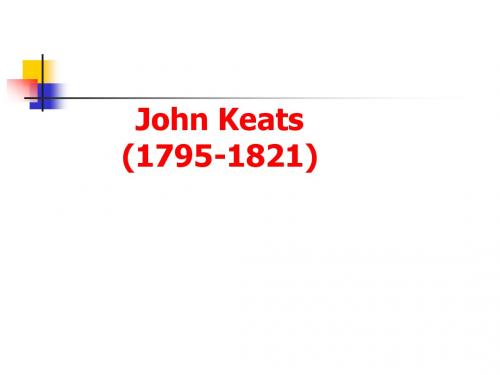
4. Special Features
The mythic world of the ancient Greece and the English poetry of the Renaissance period provide Keats with the most important imaginative resources.
he fell in love but could not marry the one he loved due to his poverty and poor health.
It was this yearning and suffering that quickened his maturity and added a new dimension to his poetry.
of the imagination on the "wings of Poesy." He imagines that he is already with the nightingale in the dark sky.
In stanza 5, the poet, "in embalmed darkness," lets his imagination tell what flowers surround him. He feels isolated from the grief of the world.
John Keats (1795-1821)
John Keats
His Life
John Keats was born in 1759 in London. His father was a stable keeper. Before he was fifteen, both his parents died. His guardian, a merchant, took him from school and appreciated him to a surgeon.
英美文学选读考试题

英美文学选读考试题一.9 authors, 20 works. (20)William Shakespearean: The tragedy of Hamlet, Prince of Denmark.Venus and Adonis, Rape of Lucrece.Daniel Defoe: Robinson Crusoe, Moll Flanders. Captain SingletonRobert Burns: My heart’s in the Highlands, A Red Red Rose. Auld Lang Syne.William Wordsworth:“The Solitary Reaper”. “We are S even”, “Lucy”, “Michael”, “Simon Lee””Lucy”I Wandered Lonely as a Cloud, The Solitary Reaper.John Keats: On First Looking into Chapman’s Homer, On a Grecian Urn, To Psyche, TO a Nightingale. “Ode to Autumn”, “Ode on Melancholy”, “Ode on a Grecian Urn”and “Ode to a Nightingale”. All were written in 1819 with the praise of beauty as their general theme.Jane Austen: Novels: Pride and Prejudice, Mansfield Park, EmmaCharles Dickens: long novel: Pickwick Papers Novels: Oliver Twist, Nicholas Nickleby, Barnaby Rudge, Great Expectations, OurMutual FriendsCharlotte Bronte: The Professor, Jane Eyre.Thomas Hardy: The Return of the Native, The Mayer of Casterbridge, Tess of the d’Urbervilles, Jude the Obscure 二,对错(10)1. Act three is the best known and most important of Hamlet’s soliloqui es among all the soliloquies in the play. In this soliloquy, Hamlet reveals his innermost thoughts and emotions, his hesitation in particular, before taking decisive action.2. Robinson Crusoe retells, in the first person singular, a sailor’s adventure on an inhabitated island.3. Defoe traces the development of Robison Crusoe from a innocent and artless youth into a clever and hardened man, tempered by numerous trials in his eventful life.4. Burn s’s poetry was written in the Scottish dialect on a variety of subjects. A large number of his poems deal with themes of love, friendship, Scottish life and nature.5. A second edition 1800 contained more poems and a preface by Wordsworth. The preface to Lyrical Ballads best read as a statement of his principle of poems.6. According to Wordsworth, he believed that “All goodpoetry is the spontaneous overflow of powerful feelings.” Thus he located many of his poems in “common life” and his poetry is distinguished by the simplicity and purity of his language.7. There he lives a life of poverty and misery, and makes friends with the lively and penniless Mr. Micawder.8. Jane Eyre maintains that women should have equal rights with men, thus this novel has drawn the feminists’ attention in t he twentieth century.三,选择(10)According to Wordsworth, he believed that “All good poetry is the spontaneous overflow of powerful feelings.”He located many of his poems in “common life” and his poetry is distinguished by the simplicity and purity of his language.四,读选文,回答问题(两诗歌,三小说)作者名字(5个40分)1.Sonnet18: Shakespearian.What is the theme of this sonnet? -- Runs in iambic pentameter, rhymed ABAB CDCD EFEF GG.2.The Tragedy of Hamlet, Prince of Denmark: Shakespearian.What dos e the “to or not to be” soliloquy tell us about Hamlet’s state of mind?―The soliloquy opens with a question,and there two other extended questions in the passage, all of which suggests that Hamlet is undecided, and either unable or unwilling to make up his mind, contemplating suicide, and disenchanted with the suffering of human life. He is cynical, but comforts himself with reflection, even though he is clearly suffering greatly and aware of his own sins and weakness.Why Hamlet hesitates before taking decisive action? -- Hamlet is often indecisive and hesitant, but at other times prone to rash and impulsive acts. Even at the end of this whole narrative of Hamlet's, he still doesn't decide on anything. He's just speaking his thoughts; he's not committing to anything. I Wandered Lonely as a Cloud: William Wordsworth.3. I wandered lonely as a cloud: William Wordsworth.What does “daffodil” stand for? ---Daffodil stand for nature in this poem, but the poet does not depict it simply as part of nature. As for Wordsworth, he dose not just want to depict the natural landscape, moreover, he pays much attention to the interaction between mature and human nature. He perceives nature as a stone of truths about human nature.Analyze the form of this poem by taking the first two lines as example. ---This poem consists of four stanzas and in eachstanza there are six lines. In each line there are four feet with a weak- strong sound pattern. The rime scheme in each stanza is a b a b c c.I wandered lonely as a cloud aThat floats on high o’er vales and hills, bWhen all at once I saw a crowd, aA host of golden daffodils; bBeside the lake, beneath the trees cFluttering and dancing in the breeze. C4.To Autumn: John Keats.What are the images used in this poem? Are they carefully arranged? --- Visual image, olfactory image, gustatory image, tactile image, auditory image. Through a series of images, make readers announcement of its scene, feeling rich concrete images.In the poem of To Autumn, he used visual image, auditory image, tactile image, gustatory image, kinaesthetic image and abstractimage to make the abstract impression of autumn specific, appreciable and more colorful. The pursuit to beauty is the way that Keats loves life, nature and also is the way he observes and enjoys life and nature. The pursuit to beau ty is his critique to the darkness of life and society. It also tells how he wanted beautifula nd ideal life in his short life.5.Pride and Prejudice: Jane Austen.Do you agree with the opening statement of the novel? What has the sentence to do with tone of the whole novel? --- Opening statement of the novel set the tone for whole novel. Writer is very serious in stating a universal truth, but what follows, however, is a very common topic of everyday life―marriage. Thus a humorous and ironic effect is achieved. Two key words appear in the statement: marriage and money, which in effect ate subject matter of the whole novel, the focus here is on the link between money and marriage.Based on your reading of the first two chapters of the novels, can you summarize the characteristics of Mr. and Mrs. Bennet? ―Mr. Bennet: he behaved sarcastically humorous, witty and capricious, and insightful in the process of showing his disrespect and dislike of Mrs. Bennet. Her mind was less difficult to develop. She was woman of mean understanding, little information, and uncertain temper. When she was discounted, she fancied herself nervous, the business of her life was to get her daughters married; its solace was visiting and news.What is your understanding of the relationship betweenmoney and marriage? --- A happy and strong marriage takes time to build and must be based on mutual feeling, understanding, and respect. Marriage can not built on the basis of money. If there is no real love between the couple, their marriage will become a tragedy eventually. Even though money can give people the comfortable house and the luxurious life, it can not buy a beautiful marriage6.David Copperfield: Charles Dickens.Dose David enjoys his life described in this chapter? How do you know? ---- David works very hard in the factory, but he could simply pay for his living. The real difficulty is that he feels very lonely, because from Monday morning until Saturday night, he has no advice, no encouragements, and no assistance of any kind. Luckily, his stay with the Micawber family in his leisure time turns out to be quite pleasant. They form a very precious friendship.Why dose the novel use the first point of view? --- It helps the author to select details. Only the events and details that David could have seen and experienced can logically be introduced into the story. The narrator’s limited view may create the effect o f suspense. 7.Jane Eyre: Charlotte BronteGive common: 性格特点:Jane Eyre is Straightforward andfeminism. Showed her concerns for the position of women particularly in English society.五,回答问题(20)William Shakespearean154 sonnets. Long poems: Venus and Adonis, The Rape of Lucrece. 38 plays.Daniel Defoe1. What are the characteristics of Crusoe from the selected reading?--- Self-reliance; patient; cheerful; clarity, courage and persistence in overcoming difficulties he start a new life in the desolate island, which demands a lot of courage and daring.Robert Burns―ScotlandA Red, Red Rose: wrote in 1794, published in 1796.1. An outstanding feature of this poem is the skillful use simile at the beginning of the poem. Draw on specific lines to explain its effect.---Simile means a comparison between two unlike items that includes like or as. For example, the first line of this poem: “Oh, my love is like a red, red rose"; al so, in this poem, "My love is like the melody". By comparing the speaker' s love to a red, red rose and a melody, readers canclearly sense the speaker's appreciation and deep love to his lover.2. This short poem is actually composed of a series of overstatements. What is the function of them? Give examples to illustrate your point. --- Overstatement is intentional exaggeration, which is, saying more that is actually meant. In this poem, when the speaker says that he will love his lady until all the seas go dry, he is using overstatement. By using this, the poet can attract readers’ attention and the sentence will leave a deep impression on the reader’s mind.William Wordsworth“The break with the conventional poetical tradition of the 18th century”. A second edition in 1800 contained more poems and a preface by Wordsworth. The preface to lyrical Ballads is best read as a statement or his principles of poetry.John KeatsJane AustenThe Plot Pride and Prejudice---Major characters: Elizabeth Bennet(the second eldest daughter of Mr. and Mrs. Bennet); Jane Bennet(first); Lydia Bennet(fifth); Mr. Bingley: a rich, single. Mr. Darcy (Mr. Bingley’sfriend who is a rich and proud young man)Theme: money and marriage.Writing style: Clarity, economy, skillful use of dialogue and tight plotting are the main features of Jane Austen’s style.Subject: Houses, money, estates run.Charles Dickens:David Copperfield:theme: the hero of the novel. The novel depicts David’s life experiences from an innocent boy to a famous wr iter. Style: Of Dickens’s fictional art, the most distinguishing feature is his successful characterization, especially male characters. Dickens was also a great story-teller. His plots were always very large, varied and complicated. However, the plots of his novels changed dramatically as he got older. In his later years, plots primarily became the vehicles for his characterization of thematic concerns, as readers may find in this novel.Charlotte Bronte-Jane Eyre four girls except Ann weres send to Charity School,三个姐妹中最大的,Unhappy life in charity school, with Emily go to Charlotte study. 性格特点:Straightforward直白的人feminism女权主义Romantic浪漫主义Thoughtful1.Give t hree instances in which Jane Eyre draws fromCharlotte Bronte’s background 1). Jane’s life in Lo wood is depicted based on the author’s own experiences in charity school where she spent some unhappy years of her childhood. 2) In Thornfield, Jane falls in love with Mr. Rochester, a rich squire who turns out to have had a mad wife. This is by and large Charlotte’s experience in Brussels where she falls in a married professor. 3) In Thronfield, Jane works as governess, and Charlotte herself worked as teachers and governess during 1837 to 1840.2.Discuss the symbolic use of names in this novel.1)“Eyre”, the surname of Jane, has the same pronunciation as “air”, which may symbolize Jane’s pursuit of freedom. 2) “Blanche”, the given name of Miss. Ingram, has its Fre nch origin, which actually means “white” in English. And it may symbolize the shallowness of Miss. Ingram.3.How does Mr. Rochester treat Jane in this chapter? What Jane’s character attract him ?To start with, Mr. Rochester shows some cruelty in his courtship of Jane so as to make Jane jealous. On hearing this, Jane could not help telling him her true feelings that she longs for equality and does not want to depart with him.?When Mr. Rochester confesses his real intention, Jane feels hurt and refuses his courtship at first.?Then she realizes his intention and accepts his love.?Her self-respect, her desire for independence, her courage, her moral strength, her passion and her personal loyalty and devotion, all these work together to make Mr.Rochester greatly attracted by her.Thomas Hardy:Hardy was a poet before he was a novelist. It was because his early verses could not be accepted that he turned to novel writing.Plot of the novel: Tess of the d’Unbervilles, Hardy’s most famous novel, has a subtitle, which is, A Pure Woman Faithfully Portrayed. It tells a tragic life story of a beautiful,naive country girl, Tess Durbeyfield.General features and comments: The whole story is filled with a feeling of dismal foreboding and doom. Father circumstances and tragic coincidences abound in the book. 12春《英美文学选读》作业1一、单选题1. How many periods are divided into in the creation years of Shakespeare? Three2. Defoe's Robinson Crusoe created the image of anenterprising Englishman, typical of the English bourgeoisie in the 18th century.3. In English poetry the _ iamb _is regarded as the most common foot.4. The excerpt The Other Side of the Island was chosen from Chapter_Ⅸ__ in Robinson Crusoe.5. "Do you think, because I am poor, obscure, plain, and little,I am soulless and heartless?。
专八英美文学习题-浪漫主义时期
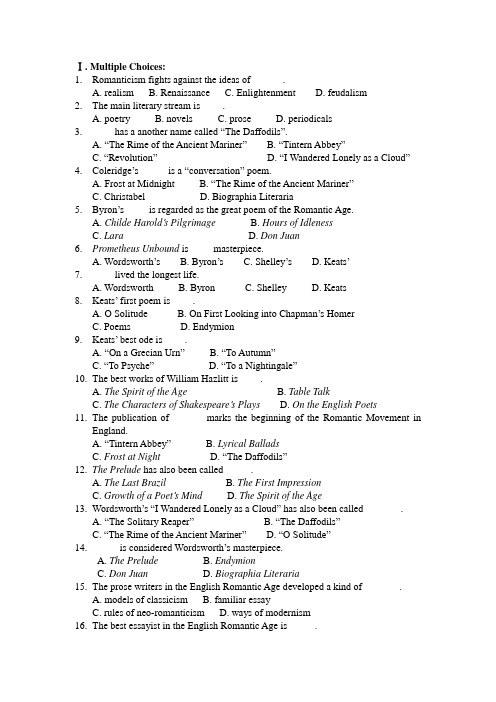
Ⅰ. Multiple Choices:1.Romanticism fights against the ideas of ______.A. realismB. RenaissanceC. EnlightenmentD. feudalism2.The main literary stream is ____.A. poetryB. novelsC. proseD. periodicals3.____ has a another name called “The Daffodils”.A. “The Rime of the Ancient Mariner”B. “Tintern Abbey”C. “Revolution”D. “I Wandered Lonely as a Cloud”4.Coleridge’s _____ is a “conversation” poem.A. Frost at MidnightB. “The Rime of the Ancient Mariner”C. ChristabelD. Biographia Literaria5.Byron’s ____ is regarded as the great poem of the Romantic Age.A. Childe Harold’s PilgrimageB. Hours of IdlenessC. LaraD. Don Juan6.Prometheus Unbound is ____ masterpiece.A. Wordsworth’sB. Byron’sC. Shelley’sD. Keats’7.____ lived the longest life.A. WordsworthB. ByronC. ShelleyD. Keats8.Keats’ first poem is ____.A. O SolitudeB. On First Looking into Chapman’s HomerC. PoemsD. Endymion9.Keats’ best ode is ____.A. “On a Grecian Urn”B. “To Autumn”C. “To Psyche”D. “To a Nightingale”10.The best works of William Hazlitt is ____.A. The Spirit of the AgeB. Table TalkC. The Characters of Shakespeare’s PlaysD. On the English Poets11.The publication of ______ marks the beginning of the Romantic Movement inEngland.A. “Tintern Abbey”B. Lyrical BalladsC. Frost at NightD. “The Daffodils”12.The Prelude has also been called _____.A. The Last BrazilB. The First ImpressionC. Growth of a Poet’s MindD. The Spirit of the Age13.Wordsworth’s “I Wandered Lonely as a Cloud” has also been called _______.A. “The Solitary Reaper”B. “The Daffodils”C. “The Rime of the Ancient Mariner”D. “O Solitude”14._____ is considered Wordsworth’s masterpiece.A. The PreludeB. EndymionC. Don JuanD. Biographia Literaria15.The prose writers in the English Romantic Age developed a kind of _______.A. models of classicismB. familiar essayC. rules of neo-romanticismD. ways of modernism16.The best essayist in the English Romantic Age is _____.A. KeatsB. Walter ScottC. Charles LambD. William Hazlitt17.The themes of Pride and Prejudice are _____.A. pride and prejudiceB. the writer’s own personalitiesC. love and marriageD. Both A and C18._____ is considered the father of historical novelist in the English Romantic Age.A.Jane AustenB. Charles LambC. William HazlittD. Waler Scottmb’s writings are full of ______for he is especially fond of old writers.A. romanticismB. conversationsC. inspirationsD. archaismsmb is a romanticist of ______.A. the cityB. the countrysideC. natureD. imagination21._____ is based on Boccaccio’s Decameron.A. EndymionB. Isabella D. Hyperion D. Lamia22.Critics agree that ____ is a great romantic poet, standing with Shakespeare,Milton and Wordsworth in the history English literature.A. KeatsB. WordsworthC. ColeridgeD. William23.The reader can get a broad panorama of the social life of the English RomanticAge from _____.A. Dun JuanB. The PreludeC. Kubla KhanD. Isabella24.Some critics think that some of Byron’s poems show his _____.A. individual heroism and pessimismB. love of nature and optimismC. love of old writersD. hatred for the imperialism25.One of Coleridge’s best “conventional” poems is _____.A. Kubla KhanB.Frost at NightC. ChristabelD. Biographia Literaria26.Coleridge’s best literary criticism is _________.A. Kubla KhanB.Frost at NightC. ChristabelD. Biographia Literaria27.____ is Shelley’s masterpiece.A. ZastrozziB. The Necessity of AtheismC. Queen MabD. Prometheus Unbound28._____ is a joint book by Charles Lamb and his sister.A. John WoodvilB.Essays of EliaC. Mr HD. Tales from Shakespeare29.Because of _______, Shelley was expelled from the Oxford University.A. The Masque of AnarchyB. A Defence of PoetryC. The Necessity of AtheismD. The Triumph of Life30.______ is Shelley’s first book written in ____.A. Zastrozzi; EtonB. The Necessity of Atheism; ItalyC. Queen Mab; GreeceD. Prometheus Unbound; Italy31.The Romantic Age began in____ and came to an end in _____.A. 1789...1821 B. 1778...1823 C. 1798...1832 D. 1768 (1819)32.Byron, Shelley and Keats belong to Romantic poets of ___ generation.A. the firstB. the secondC. the thirdD. the forth33.The Examiner is a famous _____ in the English Romantic Age.A. novelB. poemC. periodicalD. newspaperⅡLiterary Terms:1. Romanticism2. Ode3. Pastoral4. Satire5. ImageKey to the multiple choices:1-5 CADAD 6-10 CACDA 11-15 BCBAB16-20 CDDDA 21-25 BAAAB 26-30 BDDCA31-33 CBCKey to the literary terms:1. A movement that flourished in literature, philosophy, music, and art in Western culture during most of the nineteenth century, beginning as a revolt against classicism. The romanticist portrays people, scenes and events as they impress himor as he imagines them to be. A Romantic work has one or more of the following characteristics: an emphasis on feeling and imagination; a love of nature; a belief in individual and common man; and interest in the past, the unusual, the unfamiliar,the bizarre or picturesque, a revolt against authority or tradition. It expresses the ideology and sentiment of the classes and strata that were dissatisfied with the development of capitalism. There have been many varieties of romanticism in many different times and places. Some ideas of English Romanticism were expressed bythe poets William Wordsworth and Samuel Taylor Coleridge, and some were showed by Shelley, Byron and Keats.2. A long, stately lyric poem in stanzas of varied metrical pattern, written in a dignified formal style on some lofty or serious subject. Odes are often written for a special occasion, to honor a person or a season or commemorate an event. Two famous odes are Percy Bysshe Shelley’s “ Ode to the West wind” and John Keats’s Ode on a Grecian Urn.”3. From Latin pastor, a shepherd. The first pastoral poet was Theocritus, a Greekof the 3rd century B.C. The pastoral was especially popular in Europe from the 14th through the 18th centuries, with some fine examples still written in England in the19th century. The pastoral mode is self-reflexive. Typically the poet echoes the conventions of earlier pastorals in order to put "the complex into the simple," as William Empson observed in Some Versions of Pastoral (1935). The poem is notreally about shepherds, but about the complex society the poet and readers inhabit.4. A kind of writing holds up to ridicule or contempt the weaknesses and wrongdoings of individuals, groups, institutions, or humanity in general. The aim of satirists is to set a moral standard for society, and they attempt to persuade the reader to see their point of view through the force of laughter. The most famous satirical work in English literature is Jonathan Swift’s Gulliver’s Travels.5. A concrete picture, either literally descriptive, as in "Red roses covered the white wall," or figurative, as in "She is a rose," each carrying a sensual and emotive connotation. A figurative image may be an analogy, metaphor, simile, personification, or the like. Impressionism, a literary style conveying subjective impressions rather than objective reality, taking its name from the movement in French painting in the mid-19th century, notably in the works of Manet, Monet, and Renoir. The Imagists represented impressionism in poetry; in fiction, writers like Virginia Woolf and James Joyce.。
浅谈古希腊罗马神话对当今文化的影响
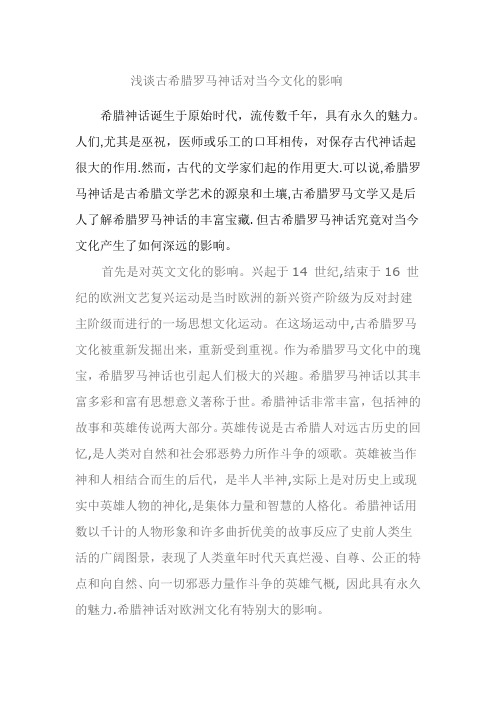
浅谈古希腊罗马神话对当今文化的影响希腊神话诞生于原始时代,流传数千年,具有永久的魅力。
人们,尤其是巫祝,医师或乐工的口耳相传,对保存古代神话起很大的作用.然而,古代的文学家们起的作用更大.可以说,希腊罗马神话是古希腊文学艺术的源泉和土壤,古希腊罗马文学又是后人了解希腊罗马神话的丰富宝藏.但古希腊罗马神话究竟对当今文化产生了如何深远的影响。
首先是对英文文化的影响。
兴起于14 世纪,结束于16 世纪的欧洲文艺复兴运动是当时欧洲的新兴资产阶级为反对封建主阶级而进行的一场思想文化运动。
在这场运动中,古希腊罗马文化被重新发掘出来,重新受到重视。
作为希腊罗马文化中的瑰宝,希腊罗马神话也引起人们极大的兴趣。
希腊罗马神话以其丰富多彩和富有思想意义著称于世。
希腊神话非常丰富,包括神的故事和英雄传说两大部分。
英雄传说是古希腊人对远古历史的回忆,是人类对自然和社会邪恶势力所作斗争的颂歌。
英雄被当作神和人相结合而生的后代,是半人半神,实际上是对历史上或现实中英雄人物的神化,是集体力量和智慧的人格化。
希腊神话用数以千计的人物形象和许多曲折优美的故事反应了史前人类生活的广阔图景,表现了人类童年时代天真烂漫、自尊、公正的特点和向自然、向一切邪恶力量作斗争的英雄气概, 因此具有永久的魅力.希腊神话对欧洲文化有特别大的影响。
希腊罗马神话对于欧洲的语言文化,特别是善于兼收并蓄的英语语言和文化产生了深远的影响。
很多希腊罗马神话中的人物典故用语都被吸收到英语当中,成为英语语言文化的有机组成部分.作为英语语言和文化的重要体现者,英美文学作品中渗透着大量的希腊罗马神话用语。
自文艺复兴运动开始,欧美的文学家们就经常以希腊罗马神话为素材进行创作。
在英国文学当中,莎士比亚曾运用希腊神话为题材创作了悲剧《特洛伊罗斯与克瑞西达》(Troilus and Cresida) , 还写了长诗《维纳斯与阿多尼斯》(Venus and Adonis) 。
19 世纪的浪漫主义诗人对绚丽多彩的希腊罗马神话更是赞口不绝。
济慈的诗歌
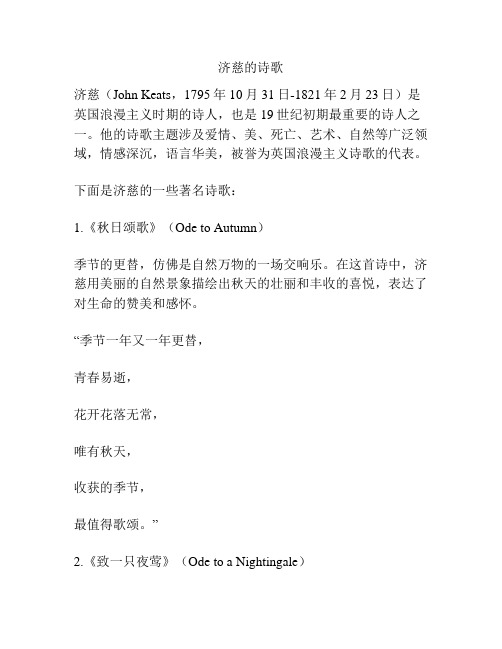
济慈的诗歌济慈(John Keats,1795年10月31日-1821年2月23日)是英国浪漫主义时期的诗人,也是19世纪初期最重要的诗人之一。
他的诗歌主题涉及爱情、美、死亡、艺术、自然等广泛领域,情感深沉,语言华美,被誉为英国浪漫主义诗歌的代表。
下面是济慈的一些著名诗歌:1.《秋日颂歌》(Ode to Autumn)季节的更替,仿佛是自然万物的一场交响乐。
在这首诗中,济慈用美丽的自然景象描绘出秋天的壮丽和丰收的喜悦,表达了对生命的赞美和感怀。
“季节一年又一年更替,青春易逝,花开花落无常,唯有秋天,收获的季节,最值得歌颂。
”2.《致一只夜莺》(Ode to a Nightingale)这首诗歌是济慈最著名的作品之一,它通过夜莺的歌声,表达了对美和永恒的追求,同时也探讨了人类存在的无常和有限性。
“离开世俗的束缚,我要沉浸在你的歌声中,和你一起飞翔,直达美和永恒的彼岸。
”3.《美女肖像》(The Eve of St. Agnes)这是一首长篇叙事诗,描绘了一个古老的传说,讲述了一个年轻的男人热切追求他梦想中的女孩。
诗歌以浪漫主义的方式描绘了爱情和美的永恒追求。
"她——美如天仙,飘逸如矫健的鹤鸣;她——悠然自在,安静如法国列车的轻盈声音;她——尤为美丽,就像一束烈火,散发着天使般的光芒。
"4.《没人欣赏槲寄生的美》(No One so Much as You)这首短篇诗歌向爱情献上了赞美。
济慈用槲寄生作为象征,表达了人们在追求美和爱情时所经历的困难和挫折。
最后,他呼吁对方在彼此的爱情中寻找安宁和幸福。
“我多少次战胜了痛苦,才得到你的爱,而你的美,却久经考验,在冬季里颤栗,在春天里任由风儿吹拂,可没有人欣赏它的存在。
”5.《翻译是译不出来的》(On First Looking into Chapman’s Homer)这首诗是济慈的一首短诗,它描述了济慈第一次读到莎士比亚的诗歌的感受。
- 1、下载文档前请自行甄别文档内容的完整性,平台不提供额外的编辑、内容补充、找答案等附加服务。
- 2、"仅部分预览"的文档,不可在线预览部分如存在完整性等问题,可反馈申请退款(可完整预览的文档不适用该条件!)。
- 3、如文档侵犯您的权益,请联系客服反馈,我们会尽快为您处理(人工客服工作时间:9:00-18:30)。
On First Looking into Chapman's Homer Much have I travell'd in the realms of gold, And many goodly states and kingdoms seen; Round many western islands have I been Which bards in fealty to Apollo hold.
Then felt I like some watcher of the skies When a new planet swims into his ken; Or like stout Cortez when with eagle eyes He star'd at the Pacific- and all his men Look'd at each other with a wild surmiseSilent, upon a peak in Darien.
Much have I travell'd in the realms of gold, And many goodly states and kingdoms seen; Round many western islands have I been Which bards in fealty to Apollo hold. Oft of one wide expanse had I been told That deep-brow'd Homer ruled as his demesne; Yet did I never breathe its pure serene Till I heard Chapman speak out loud and bold: Then felt I like some watcher of the skies When a new planet swims into his ken; Or like stout Cortez when with eagle eyes He star'd at the Pacific- and all his men Look'd at each other with a wild surmiseSilent, upon a peak in Darien.
the key figures in the second generation of the Romantic movement.
John Keats
(1795--1821)
Born in London on October , 1795. He was the first son of a stable-keeper
When he was 8, he attended a good school but later was taken from school to an be apprentice
to a surgeon.
In 1814 he gave up the apprenticeship and became
ቤተ መጻሕፍቲ ባይዱ
Structure
scheme: abba abba cdcdcd(cdecde)
Homer
古希腊盲诗人,通译为 荷马。生平和生卒年月 不可考。相传记述公元 前12~前11世纪特洛伊 战争及有关海上冒险故 事的古希腊长篇叙事史 诗《伊利亚特》和《奥 德赛》
济慈阅读的为查普曼所译的 《伊利亚特》,之后济慈深深 地被诗中所蕴含的生机所触动。
hospital student in London. In 1814 Keats finally give up medicine for literary pursuits.
In 1819-1820, he completed his most mature works. He died on 23 February 1821 and was buried in the Protestant Cemetery, Rome.
我曾游历过许多黄金般 的王国, 看见过众多美好的城邦 和国度, 还曾周游过许多西方的 岛屿 那是诗人的地域来俯首 阿波罗。
Oft of one wide expanse had I been told That deep-brow'd Homer ruled as his demesne; Yet did I never breathe its pure serene Till I heard Chapman speak out loud and bold:
Works
On First Looking into Chapman's Homer Ode to a Nightingale Ode On melancholy Ode to Psyche Ode On a Grecian Urn Bright star 《初读查普曼译荷马 史诗有感 》 《夜莺颂》 《忧郁颂》 《赛姬颂》 《希腊古翁颂》 《灿烂的星》
On First Looking into Chapman's Homer
Keats's former schoolteacher introduced him to Homer in the translation of Chapman. They read through the night, and Keats walked home at dawn: this sonnet, his first great poem, reached his teacher by ten o'clock at the same morning.
